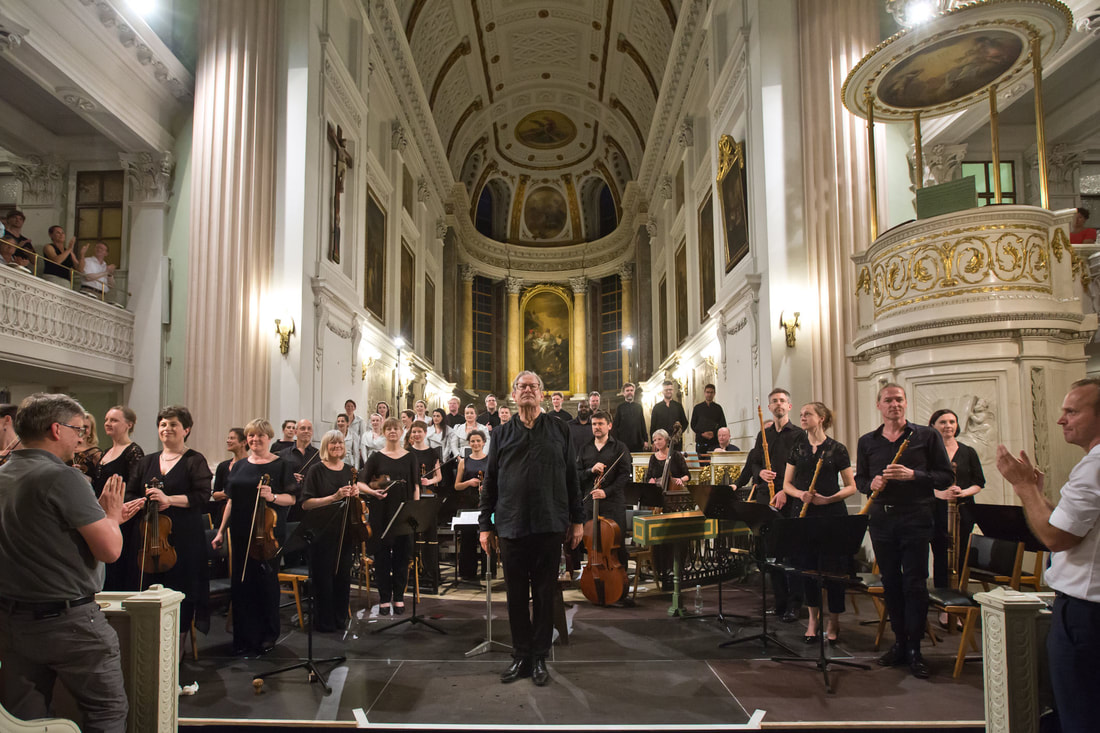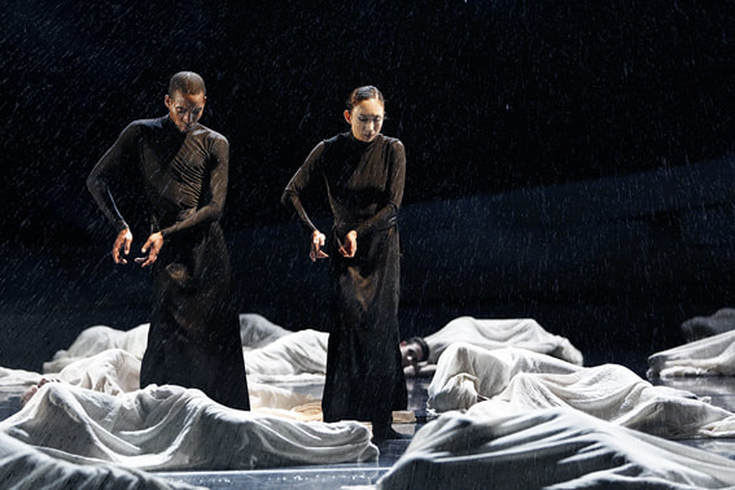|
RING OF CANTATAS This year's BachFest featured something special. A Ring of Cantatas, sung in Thomaskirche and Nicolaikirche. Under the baton of John Eliot Gardener, Ton Koopman, Hans-Christoph Rademann and Masaaki Suzuki - conductors with a complete recording of Bach's cantatas (the ones that survived ink corrosion, flames and other mischief) under their belt - a rarely seen (and heard) series of concerts were given in which 33 of the best cantatas (and yes this is subjective) were played within a 48 hours timespan. Contractual obligations refrained Bach from composing operas. The cantor of Thomaskiche was not supposed to occupy himself with such worldy matters. But changing times and the accompanying relaxation in the relationship with religious heritage have brought Bach to the opera house after all. JOHANNES PASSION For me BachFest started with Johannes Passion, a 2017-production of Opera Leipzig, in which Bach's most dramatic of passions was paired with modern dance. In a choreography of Mario Schröder, the clerical music of Bach was staged with a worldy ballet. A ballet in which Schröder did not bother, and rightfully so, to put a literary telling of Jesus' cloister on stage. What can be heard in music and text needs no doubling on stage. More than a depiction of the crucifixation, the ballet was a rendering of themes, lying beneath the story of Christ. A visualition of a story about suffering and the need for salvation. The need of humans to appoint someone savior. The ballet put the story in a world of decay. A world with a possible chance for a new beginning, awaiting at the end. Together with the theatrical and dramatic element already in the music this Johannes Passion obtained with its vividness and sensual aspect of contempary dance by times the energy of a rock opera. Jesus was not played/danced by one person but by a pair of dancers: one man and one woman. A Jesus-tango of sorts, dressed in black, as to seperate them, in image, from the rest of the dancers: the crowd and the Pharisees that would eventually come for Jesus' blood. The couple that was Jesus danced with each other, danced against each other, as to depict an inner struggle, and kept themselves at save distance from their environment. Their duet was, although not devoid from sensuality, a somewhat stylistic affair, it never reached, let's say, a Cherkaoui-kind of rapture or tempation. The couple never fully interwined as if Jesus, the supposed savior of mankind, was a broken person. A person that was looking for balance and salvation him/herself. With "Ruht Wohl", that ending of Johannes Passion that never fails to move, it started to rain. It was an ending that supplied Bach's oratorium with a stage filled with bodies, presumably dead, covered with blankets - worthy of anything this side of Götterdämmerung. A pairing of the end of the world with the resurrection of Christ. The Jesus-couple kept dancing till the end, against all odds. As if their continuing doing so would save the world, if only in mind, from perishing. Thus keeping the illusion alive that mankind was redeemed and offered a new start. In this setting, the role of musicians and singers was limited (if one can say that when Bach's music is played) to a guiding one. The musical direction was in the hands of Paul Goodwin who led the Gewandhausorchester in a swift and energetic reading of the score. Martin Pertzold was a versatile Evangelist and Alexander Knight a powerful Jesus. In comparison with her male colleagues the soprano of Magdelena Hinterdobler sounded a bit stiff, as if she wasn't performing up to her abilities. It was a performance in which the ballet was up to a difficult task: to provide Bach's oratorio with a worthy visual counterpart on stage. It worked for the better part, thanks to a choreography that left enough room for interpretation and did not bother to literary depict a story that was already very present in music and text. The undoubtedly good intentions behind the added intro - with a call to prayer from a mosque and a synagogue, as a reference to topical times with it tensions between religions - did not save that intro from falling flat on its face. It sounded like a technical error rather than a convincing start. But then, what else than the stirring Herr, unser Herrscher is a better start for the oratorio that, as it was proven here again, can serve as an excellent music drama? BACH FOR BRUNCH The next day I had Bach for brunch. Together with cantates of Heinrich Schütz (composer of the first German opera - "Dafne" in 1672 - and considered a founding father of lutheran baroque), Telemann and instrumental music of Biber, a musical brunch was served in Alte Börse. An old Exchange in the centre of Leipzig that housed a concert that was, on all counts, a heartwarming event, The heat made a repeatedly tuning of the violins necessary, sweaty as the gut strings became in these tropical circumstances. In the cantatas of Schütz, Telemann & Bach, mezzo-soprano Genevieve Tschumi sang divine melodies with gravity and beauty and delivered them with the qualities of someone who doesn't only know how to sing but - as if the cantatas were "Lieder" - also know how to act. This musical brunch was followed, later that day, by an organ concert by Johannes Lang in the Gewandhaus. A concert that was an encounter with that other famous inhabitant of Leipzig, Felix Mendelssohn. Lang delivered the sonates for organ from Bach and Mendelssohn with finesse and fury on the most majestic and theatrical of all instruments. In Mendelssohn Sonate A-Dur op. 65, the Fuga led to a frenzy in the audience. It was as if a mad professor, sitting in a high castle, turned his drift for world domination into the most frantic of heavy chromatic music.
- Wouter de Moor BachFest Leipzig: 8 - 10 June 2018 Festival dates: 8 - 17 June 2018 For BACH/BLOG see also:
1 Comment
|
TIMELINE
July 2024
|




 RSS Feed
RSS Feed